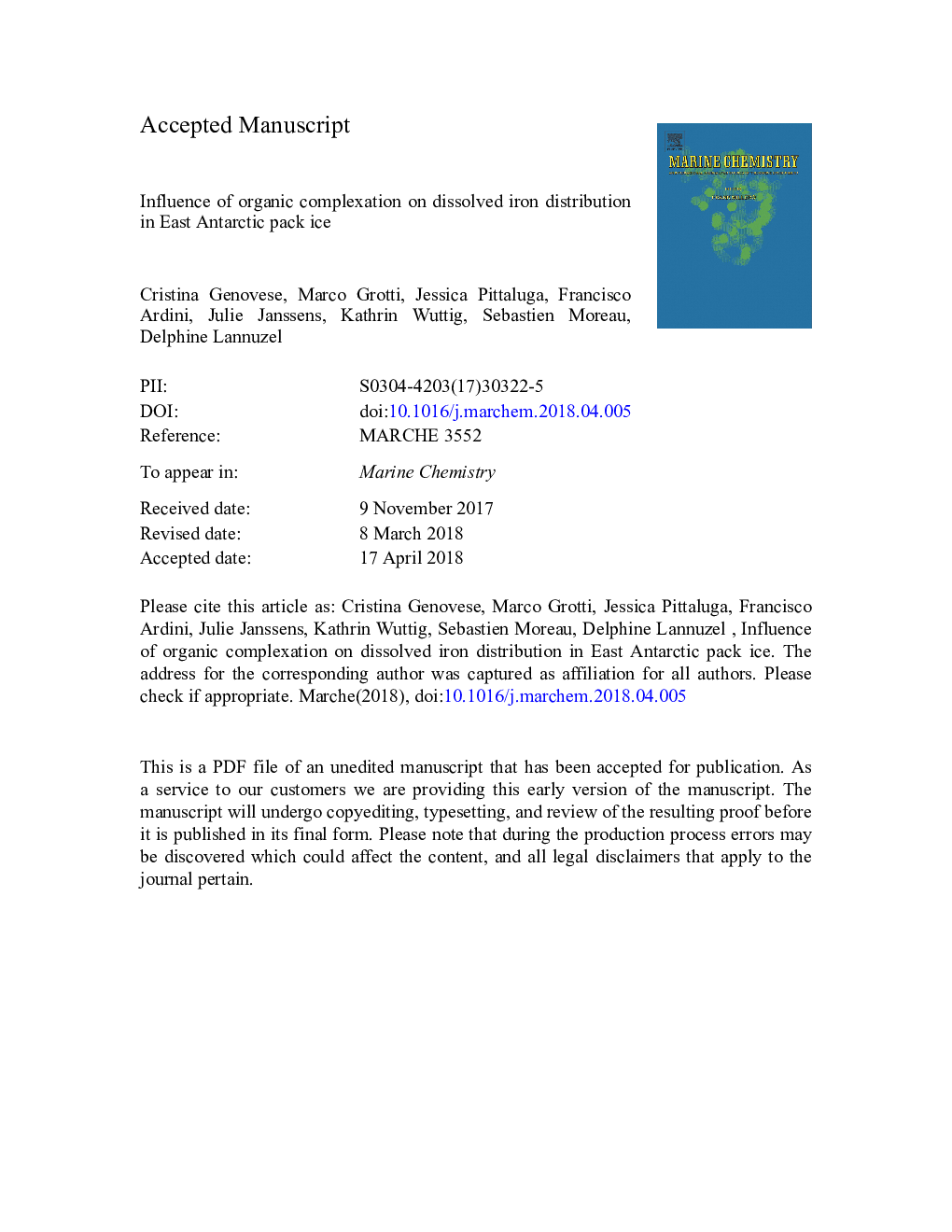| کد مقاله | کد نشریه | سال انتشار | مقاله انگلیسی | نسخه تمام متن |
|---|---|---|---|---|
| 7698786 | 1496633 | 2018 | 41 صفحه PDF | دانلود رایگان |
عنوان انگلیسی مقاله ISI
Influence of organic complexation on dissolved iron distribution in East Antarctic pack ice
ترجمه فارسی عنوان
تاثیر ترکیب آلی بر توزیع آهن محلول در یخ بسته قطب جنوب شرق قطب جنوب
دانلود مقاله + سفارش ترجمه
دانلود مقاله ISI انگلیسی
رایگان برای ایرانیان
کلمات کلیدی
نوع خاص آهن، یخ دریایی، بسته یخ، لیگاندهای ارگانیک، اقیانوس جنوبی،
موضوعات مرتبط
مهندسی و علوم پایه
شیمی
شیمی (عمومی)
چکیده انگلیسی
Since Antarctic sea ice covers an area larger than the Antarctic continent itself, the discovery that it can fertilize the Southern Ocean with iron (Fe) has fostered a new breadth of research in recent years. In order to test the hypothesis that Fe-binding organic ligands control the distribution of dissolved iron (DFe) in Antarctic pack ice, iron organic speciation was investigated in samples collected during the Sea Ice Physics and Ecosystem eXperiment-2 (SIPEX-2) voyage in Austral winter/spring 2012. Dissolved Fe was measured using sector field inductively coupled plasma mass spectrometry, and iron organic speciation parameters were determined by competitive ligand equilibration - adsorptive cathodic stripping voltammetry method, using 1-nitroso-2-naphthol (NN) as the added ligand. The concentration of Fe-binding organic ligands (Lt) ranged from 4.9â¯nM to 41â¯nM (average of 14.9â¯Â±â¯8.4â¯nM, nâ¯=â¯34), and was always higher than the corresponding DFe (average of 7.5â¯Â±â¯4.5â¯nM, nâ¯=â¯34). Conditional stability constants (log Kâ²Fe'Lâ¯=â¯11.7-13.0) were similar to those previously observed in land-fast ice. Concentrations of DFe and Lt displayed similar depth profiles; their strong correlation (Spearman's Ïâ¯=â¯0.80, pâ¯<â¯0.001) suggested that Fe-binding organic ligands control DFe distribution in Antarctic pack ice. Unlike results previously obtained for land-fast ice, Fe-binding organic ligands in pack ice were never saturated with iron (Lt/DFeâ¯>â¯1). Estimates showed that pack ice would have released 0.45â¯Î¼mol/m2/d of Lt during spring melt, 0.21â¯Î¼mol/m2/d of which are free from Fe binding, and hence available for further complexation. Therefore, it is suggested that this excess of Fe-free ligands may play a key role in controlling the solubility of free or newly formed Fe in surface waters before the peak of primary production, outcompeting the Fe-binding organic ligands already present in seawater.
ناشر
Database: Elsevier - ScienceDirect (ساینس دایرکت)
Journal: Marine Chemistry - Volume 203, 20 June 2018, Pages 28-37
Journal: Marine Chemistry - Volume 203, 20 June 2018, Pages 28-37
نویسندگان
Cristina Genovese, Marco Grotti, Jessica Pittaluga, Francisco Ardini, Julie Janssens, Kathrin Wuttig, Sebastien Moreau, Delphine Lannuzel,
